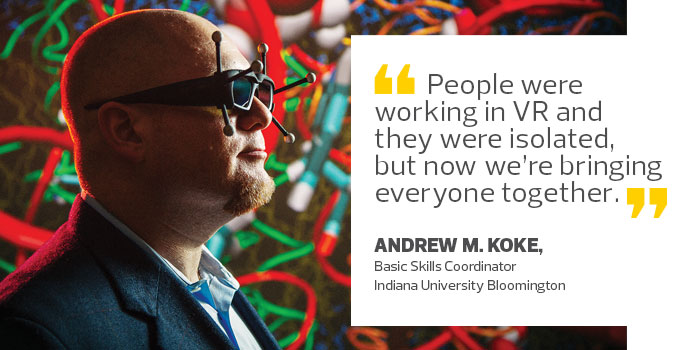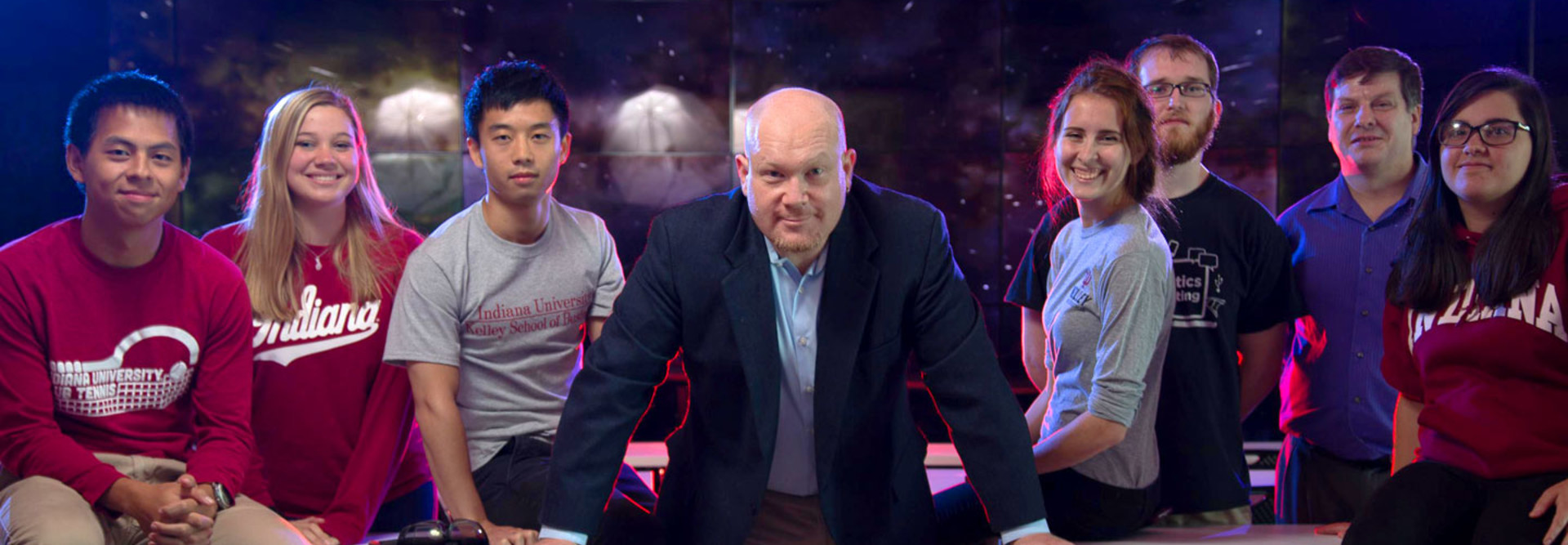Q&A: In Indiana, Virtual Reality Poised to Bring High-Impact Experiences to the Classroom
Andrew M. Koke has a Ph.D. in history, but his focus is firmly on the future. Koke, a faculty member in the Student Academic Center at Indiana University Bloomington (IUB), is leading an effort to create an academic virtual reality space on campus. Participants — two dozen administrators, faculty and researchers representing a variety of academic disciplines — ultimately want to establish a full VR classroom. Koke recently spoke with EdTech Managing Editor Amy Burroughs about the initiative, which he says has the potential to transform education through high-impact learning experiences.
EDTECH: You’re a history Ph.D., and you’re working on VR. How do these complement each other?
KOKE: One of my primary loves is good pedagogy and classroom experience. When I first started messing around with VR, I was absolutely shocked by how transportive the technology is. My very first thought was, “Where can I take my history students on virtual tours?” We have one professor on campus, Bernie Frischer, who is working on a re-enactment of ancient Rome that would allow students to experience in VR what it was like in those times. Google Cardboard recently released a Gettysburg expedition.
From a historical perspective, this is incredibly compelling. There are going to be certain students in your classroom who are interested in the text, who enjoy the reading and the discussion, but for some students, this would be incredible to experience what some historians say likely happened. It’s visceral and it’s new.
So I came at it from a historian’s perspective, but since I started exploring VR and augmented reality, it’s gone far broader than what I possibly would have imagined. When I first started thinking about it, I think I was thinking too small. As I’ve been partnering with people on campus, we have artists who are working on brand-new types of art. We have doctors and physicians who are thinking about VR in medicinal programs. I’ve heard from people in the music school. Could you virtually play a piano and practice that way? I’m excited. As the technology intersects these different disciplines, people are dreaming so much more broadly. It’s fun.
EDTECH: How did IUB’s VR initiative get started?
KOKE: We began working together in June. The Rift and the Vive hit in April and May, and I started playing with those. As soon as I took off the headset, I said, “Oh my gosh, this is going to transform almost everything, but it’s especially going to transform my area of interest, which is education.” When I came back to campus, I started emailing different people. One or two people would know so-and-so, who was also interested in VR. This is all word of mouth. As we all began talking, it became clear there is a group of people here who have already been dabbling in this area and, for some people, more than dabbling. Some people have been researching earnestly in AR and VR. We have a student who, in the spring semester, put together a petition requesting a VR lab and had over 200 students sign it in three days. So the demand is high.
Now, we have a very broad team of close to two dozen researchers, administrators, faculty and staff. I’ve been so pleased with the amount of attention that the campus has on this subject and pleased with the diversity. We have essentially every school represented, and many disciplines within different schools. At the administrative level, we have many deans and a vice provost. The libraries are interested. So we have a lot of enthusiasm on campus.
What seems to be the case is that people were working in VR or interested in VR and they were a little bit isolated. Now we’re bringing everyone together and trying to partner with some of the existing strengths on our campus to create a unique experience for our students, prospective students and faculty.
EDTECH: What goals is the group working toward?
KOKE: Our short-term goal is to create a small VR workstation on campus, potentially in Wells Library. We have a very active learning commons in that library, which includes a lot of high-technology equipment. We think that would be a wonderful place to put an open VR lab, which might have four workstations, and to allow students and faculty to reserve time to use the space for classroom work and for research on a small scale. It wouldn’t have an enormous amount of overhead or space requirements. That library is centrally located, it’s a hub of intellectual activity and it’s a place that prospective students and parents visit. The library is considering that proposal, although I suspect there are a lot of departments that would be willing to host something like that.
We already have on campus the Mark Cuban Center for Sports Media and Technology. Its foremost vision is regarding VR and athletics; however, that is not its singular mandate. So we would like to partner with them to continue the work they’re doing in VR and to make it more widely accessible to the campus. That’s what I mean by leveraging some of our existing strengths. The Mark Cuban Center and the Advanced Visualization Lab, which has been on our campus for 19 years, are two existing strengths that we think we can partner with and expand without being redundant.
Long-term, we want to conceive of an actual classroom space with, we’re hoping, 20 to 30 headsets. Right now I’m not even sure if the technology permits that many headsets to be in one space. But it would be interesting if we had a classroom where 20 or 30 students and their faculty could experience some of the same things simultaneously. That is a longer-term dream. It would have much different requirements in terms of resources of space, technology and cost, but it is on our radar.
It’s hard to imagine that this won’t happen at some point. We just don’t know when. I think that if we were to do a small workstation for proof of concept — and this is what I think a lot of universities are moving toward — that allows people to begin to dream, to research and to figure out some of the salient questions regarding education and VR or AR. From that can come all kinds of different enterprises and experiences.
We also think VR is going to be a game changer in online education. We’ve seen a little bit of this at other institutions. It’s clunky right now. VR is promising things that aren’t here yet. One of the main reasons that online students have a low rate of completion is because they feel disconnected from their fellow students and professors. VR would make it possible for a student to experience a classroom that has other people in it, raise a virtual hand, ask a question, give a speech in front of other people who can interact, go up to a chalkboard and work on some project. All of that becomes easier with VR, eventually.

EDTECH: Although there are pockets of VR activity in higher education, more content is needed. How far behind is the development of content for VR applications?
KOKE: Significantly, actually. Our Advanced Visualization Lab has been working with very expensive pieces of hardware for 19 years creating virtual spaces. What’s changed is that in April and May, with the Vive and the Oculus Rift, the hardware suddenly became far more financially permissible. The hardware and some of the research have been there for more than a decade, but now, this is something that can be mass-consumed.
It’s still got a high startup price — the Vive and the Oculus Rift are $800 and $600, respectively — but that’s still well within the realm of possibility. It’s completely conceivable that most universities could create one to two workstations that would allow students to have all kinds of experiences, and from that will come creativity from both students and faculty. So there’s a new era, and it’s an era that makes it financially permissible for almost any institution to have some of these workstations in place. But, you’re right, the applications are not quite here as broadly as we would like. So it’s a multiple-step process. We can’t really get the applications until we already have some things in place that let people dream, and dream broadly.
I think that Google is actually one of the lead players; I know they are at the K-12 level. But what they’re doing in K-12 isn’t inappropriate for the college level. We wouldn’t be doing the same modules, obviously, that a K-12 classroom might be considering, but some of the content, like going to Gettysburg or going to the Great Wall, can have play in a college classroom as well. It just has to be handled a little bit differently.
EDTECH: Do you think higher education could become a leader in VR through research and teaching applications?
KOKE: I do think that’s the case. In my lifetime, the two biggest technological advances have been the growth of the Internet and the ubiquity of smartphones. Both of those have been transformative in terms of our social interactions and a little bit in education, but not as much as you would have thought. And it took a while for both of those to interact with higher ed. But it seems as though the educational payoff for AR and VR is ahead of the game compared to those other two technologies. This is really evident with what Google is doing with K-12, but I think it’s coming to higher ed as well. Unlike the smartphone, which higher ed took some time to adopt and utilize, I do think AR and VR will have much faster access in higher education.
EDTECH: As someone who has studied instruction and pedagogy, how do you believe VR can enhance student learning?
KOKE: What we have is the chance for high-impact educational practices to be more publicly available and at lower cost. Everyone knows that an internship is a wonderful educational experience, but the truth is it’s a huge usage of resources and time. Not everyone can do these things, so they’re not equally available. Study abroad is another fantastic, high-impact educational possibility, but again not everyone has access to it and it’s sometimes prohibitively expensive. These are educational experiences that are different than what you would normally get in a brick-and-mortar classroom where you sit in the seat, listen to the professor and interact with the professor and the materials. What VR allows is a host of new experiences to be added to the brick-and-mortar classroom. For example, we could take a quick field trip to World Heritage Sites or we could be an anthropologist and be a fly on the wall in some other person’s experiences to see what their life is like. We could take a language course and then talk to a native speaker in another place. Normally, that would only be available if you took some kind of international travel; with VR, maybe it’s much more available at your local library with one of these new sets. Then, of course, there are new experiences in terms of creativity with art and music.
So what we’re really talking about here is a completely new range of experiences that are now in the realm of financial possibility for a lot of students and in the realm of excitement and curiosity.
EDTECH: It’s interesting to imagine that 50 years from now, professors looking back on our time will ask, “How did they ever teach without this tool?”
KOKE: That’s how we think it’s going to go, and we want IUB to be at the forefront of that. Another area we’re starting to think about is disability services. We have a lot of students on campus who have various disabilities, and there are certain disabilities that research has suggested might benefit quite a bit from AR and VR. Attention deficit disorder students might find this technology incredibly engaging. Some research suggests that autistic students have a good interaction with VR as well. So one of the things we’re interested in is how much this new technology will make certain experiences more available to certain students. That is a worthy question for the technology.
EDTECH: Where is VR in higher education today?
KOKE: I think the hardware is here. The head-mounted displays tied with some of the new video hardware that’s come out have made these portable and in the realm of financial feasibility. Surprisingly, the applications are not as far off as what people have been saying. Because a lot of the applications are built on software that has been heavily used in video games, there is actually a rich knowledge and expertise, especially in the video game industry, for this kind of technology.
I know that a lot of people put AR and VR about two to three years out for higher education. I’d move that up a little bit. I think we will have some applications that can be compellingly used in the classroom in as soon as a year.
EDTECH: What other VR applications has the group identified?
KOKE: Once people encounter the technology and begin to dream a little bit and it enters their area of expertise, we hear some brilliant ideas. One recent conversation I had was with librarians talking about 3D artifacts and other archives that might be available quite broadly with VR. Right now, if you wanted to see some archive in Nevada or Oklahoma, you would have to travel there. That makes it prohibitive for some research, especially undergraduate research, to occur, because of the distance and financial constraints. But if that was virtual 3D, where you could look at the artifact, move it around and have access to it in a way that you might not even be able to if you were there, it opens up a whole new access to certain kinds of research.
Documents is another area. One thing we’ve lost with digital documents is the value of being in the stacks, looking at a lot of books and seeing what’s around the book that you’re looking for. One thing people are talking about is a digital VR library, where you go into the stacks and you can see the book you’re looking for, but you can also see all the ones around it that are near enough to the subject matter that they might be pertinent to your research.
Obviously, we have The Media School here that’s interested in sports entertainment, music entertainment and events like that. Digital gaming — those applications are pretty clear. And of course, Hollywood is interested in this virtual experience and movies that a person can actually be immersed in more than just watching.
Biology students could begin practicing on VR labs that are actually seen in pharmaceutical companies or hospitals. Maybe they don’t have the time or ability to go to those places, or maybe those places don’t necessarily want undergraduates wandering around their halls, but if you made a virtual lab and gave students access, they could begin practicing well before they actually hit the job market. So we think in terms of training, a virtual lab could be beneficial, too.
EDTECH: The possibilities seem limitless.
KOKE: Yes, and that’s exactly what I’m trying to convey to the campus. I’ve been a computer geek for all of my life. When I put on the headset for the first time, I thought to myself, “I’ve done other VR things. I’ll be able to see the cracks here. I’ll be able to see through this.” But honestly, the technology has become so immersive that it was extremely convincing. It really did fool me.









